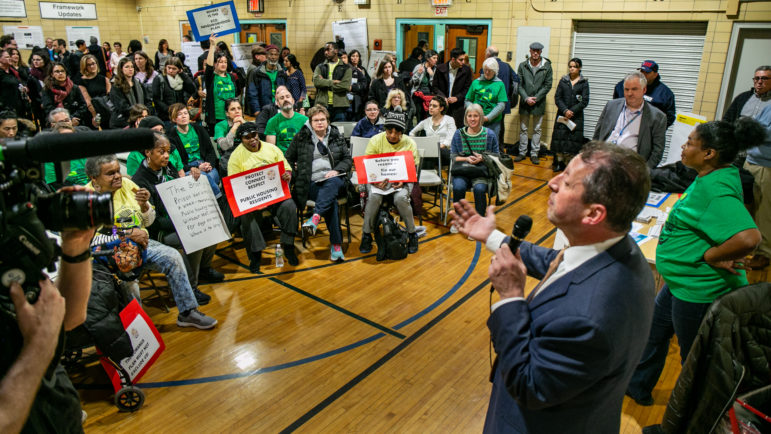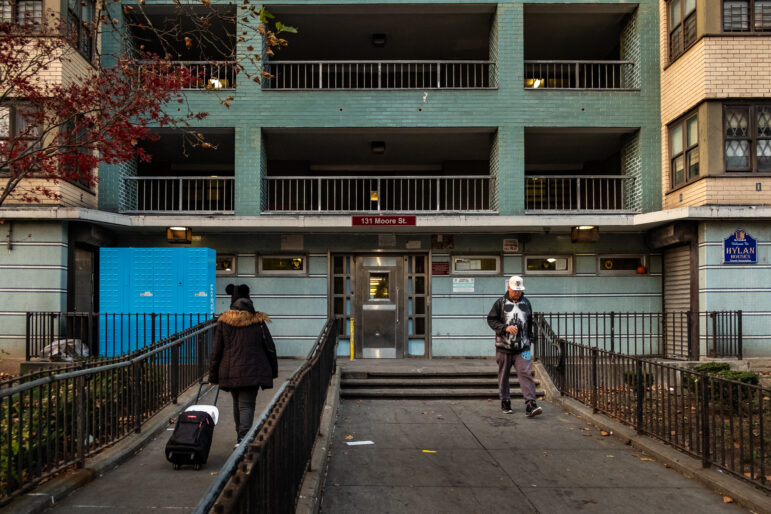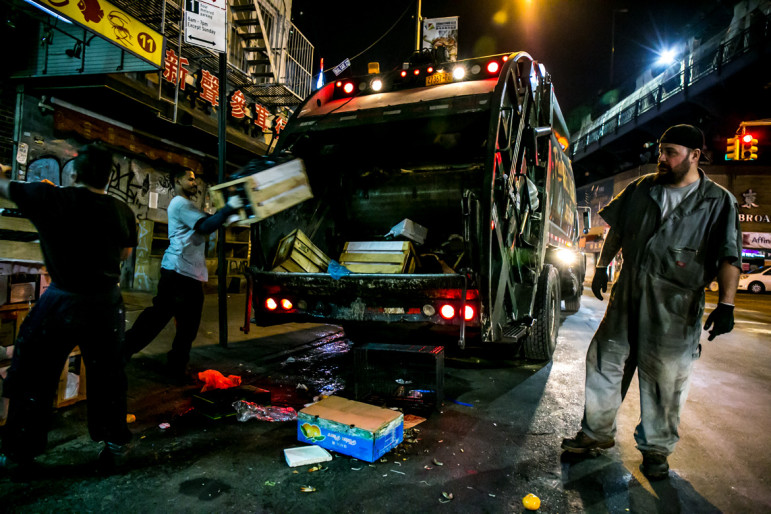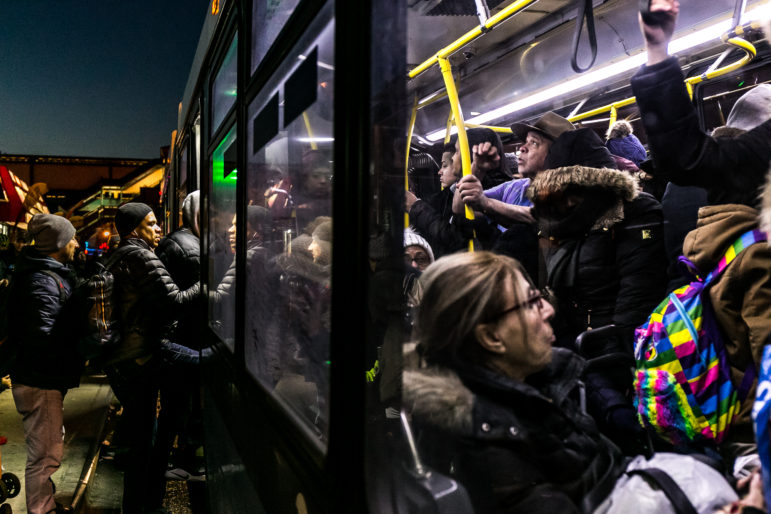
Adi Talwar
City Councilmember Brad Lander addressing attendees of the Department of City Planning’s open house on February 6, 2019 at PS32 on Hoyt Street to discuss the draft Gowanus rezoning proposal.Real-estate developers are just itching to rezone Gowanus and reap the financial rewards, but we question the wisdom of doing so right now. The current limitations to large in-person gatherings and public engagement due to the pandemic substantially undermine the key process by which the public holds power accountable during land-use reviews.
In the face of pressure from those who would benefit directly, the City of New York now plans to restart the paused Uniform Land Use Review Procedure (ULURP) in September, with preliminary presentations in August. If approved, the proposed Gowanus action would be the largest rezoning under the de Blasio administration, and any action that would dilute the public’s right to know and to participate could have far-reaching consequences. We understand proponents’ eagerness, but it is critical for the public to have a fair chance to weigh in meaningfully in a standardized manner on changes that will dramatically affect their lives, health, property, livelihoods, and neighborhoods. That’s essential. In fact, that was the entire reason ULURP was instituted three decades ago.
At its best, ULURP provides little meaningful room at the table for the community. Given the realities of our times, we must ask: how can an already inadequate process that does not currently allow safe, in-person, large-scale community meetings at every step of the process across seven months be fair and sufficient under the law? It can’t.
Certainly, the review procedures would not be uniform when considered alongside other city-led rezonings to date. Proceeding with virtual meetings where attendees cannot even see who else is in the meeting prevents the public from engaging in the actions that provide them with their only power in the process. As such, it would be neither fair nor legally sufficient. To be able to coordinate, cheer, clap and even boo from time to time is an essential part of the process – and that can only happen at a large, in-person meeting, the kind where it’s possible to hold signs or wear clothing sporting advocacy messages. Gowanus residents have the same right to meaningful civic engagement as other neighborhoods that were rezoned.
Virtual meetings are inadequate given what’s at stake in this ULURP. City officials, as we’ve seen, have total power to mute an attendee in a virtual meeting – cutting off another one of the classic avenues open to a citizen attending a public meeting: the ability to finish your point after an official has cut you off. This matters in Gowanus, where public meetings, especially those surrounding the proposed rezoning, rarely resemble a Norman Rockwell painting. Instead, they are often examples of the grit and gristle that emerge in a heavily contested space and are part of the fabric of New York City’s tapestry. Community members must be allowed to be in the same room as their elected and agency officials and to be able to confront those decision-makers – whether community board members, the borough president, city planning commissioners, or city council members – where the tension is not merely abstract.
Shifting to virtual meetings also presumes that all who could attend a traditional in-person public meeting can access the Internet and utilize a program like Zoom in the first place. It leaves behind all those who are not capable of getting online because of access issues or adequate internet connectivity. Alternatively, proceeding with large in-person meetings when many people do not feel safe attending them is not fair to Gowanus residents.
 CityViews are readers’ opinions, not those of City Limits. Add your voice today!
CityViews are readers’ opinions, not those of City Limits. Add your voice today!
Zoom meetings may be sufficient for certain public matters and may even draw in a wider audience in some cases. However, they cannot provide adequate civic engagement opportunities for a massive rezoning that will result in displacement of people and businesses, that would lead to major residential development in a flood zone, that would allow housing to be built on top of heavily polluted sites, and that would lead to a reduction in manufacturing zoning. The community must also be able to forcefully and publicly push for a better approach on affordable housing, which always gets short-shrifted in big development deals, given the dwindling stock of affordable housing in the area. Further, this rezoning will not require a racial impact study before proceeding, although we support such a study, and adequate attention must be paid to this issue in the ULURP.
Forging ahead on-line at this juncture would suppress the vital public participation and oversight that is guaranteed to City residents by ULURP. Let’s hit the “pause” button on the rezoning until safe, in-person, full-scale community meetings are possible.
Assemblymember Jo Anne Simon is a Democrat representing the 52nd District (Brooklyn Heights, Downtown Brooklyn, Cobble Hill, Carroll Gardens, Gowanus, Park Slope, Boerum Hill and DUMBO) and Bradley J. Vogel, esq., is a Gowanus resident.









15 thoughts on “Opinion: Fairness Requires that NYC Pause the Gowanus Rezoning”
Bravo, Jo Anne and Brad! We need a moratorium on rezoning Gowanus until we get the same ULURP all other NYC neighborhoods got.
Any new developments, like elsewhere in the city that have been rezoned, would undoubtedly have elevators. The current housing almost all walk-ups. It’s disappointing, given Assemblymember Simon’s history advocating on behalf of people with disabilities that she opposes improving access.
Zoom meetings absolutely bring in wider public involvement. People who have to work hourly jobs for wages, particularly essential employees, who are disproportionately people of color, can’t attend in person meetings, whether in the time of COVID-19 or not. Wealthy retirees and lawyers and Assembly members, on the other can, can easily find the time.
Bringing in more people via Zoom does not mean it’s representative of the public.
Zoom meetings do not absolutely bring in wider public involvement. It presumes that everyone has equal access to the technology required, and the ability to use that technology comfortably.
As a Gowanus resident, I thank Assemblymember Jo Anne Simon and Mr. Bradley Vogel for this excellent and articulate explanation of why NYC needs to pause the Gowanus rezoning until the entire community can have a fair chance of weighing in. The photograph clearly shows community engagement and participation that can not be replaced by Zoom. The community has a right to the same process that other rezonings have had. The proposed Gowanus rezoning is huge, larger than Hudson Yards. For NYC to try to shove this rezoning through, using Covid 19 to the advantage of the developers who want to see it shoved through, is transparently ugly, to say the least, and unfair to the ommunity.
ABL4C! Anybody But Lander For Comptroller! The only way to stop this rezoning giveaway to developers is to tell Lander he will not become controller. It’s really that simple.
This is a clear and succinct assessment of why the city’s rezoning plans have to be delayed until we can meet again in person as a community. The Gowanus community has been highly involved in creative and productive ways during the entire rezoning process. We need to continue the amazing civic engagement displayed by Gowanus residents in this important rezoning process and this can only be done in person for all the reasons mentioned in this article.
Thank you Assemblymember Simon and Mr. Vogel for saying what is so obvious. A Zoomed ULURP would be tantamount to holding these ‘public meetings’ behind closed doors.
To strike at the core of our democracy in this way, for the sake of expediency for a few elite developers, is just plan wrong.
Nothing fair about ignoring the manufacturing community
Amen! And THANK YOU! , Jo Anne and Brad!
We in Gowanus/Carroll Gardens/Boerum Hill (and beyond) Communities absolutely need a MORATORIUM! on rezoning Gowanus until we get the same ULURP all other NYC neighborhoods got.
It is clear as day.
We are owed that at the very least for such a massive, proposed, zoning change to our existing communities. As residents we demand a right to our collective voice and to be treated by New York City with fairness and respect!
“To be able to coordinate, cheer, clap and even boo from time to time is an essential part of the process – and that can only happen at a large, in-person meeting…” It’s kind of disturbing that a government official would say this. Those kinds of meetings have never been productive and always skew perception of who the “community” is and how people feel about a project. Allowing the loudest voices in the room to veto everything is no way to effect change.
Zoom creates more public involvement by allowing a greater number of people to participate, from wherever they are, and not get bullied into being quiet. A real meeting allows everyone who wants to speak time to say their piece. And you don’t need a computer or smartphone, you can call in with a regular phone.
James, do you really think that “calling it in” is the same kind of active participation and engagement as actually being physically present at a community meeting? I Zoom regularly, and the people who just call in do not have the same level of participation – they cannot see anything. And the Zooms I do are small in scale – and even with as few as 4 people, it can get chaotic fast with people speaking over each other, people on mute, dogs barking in the background, you name it.
How many decades worth of studies is going to be enough to satisfy you NIMBYs that the neighborhood can and will inevitably change. There’s already been more than a decade of debate on this issue…this isn’t a Robert Moses type of authoritarian affair. What will additional reviews accomplish? We already know displacement is happening, we already know the land is polluted, and we already know manufacturers are leaving the area because of market pressures. Rezoning or not Gowanus IS changing, and at least this plan offers a cohesive and comprehensive approach to manage that change. The alternative is the piecemeal and haphazard type of new development that’s currently taking place all over the neighborhood. The new buildings currently being built without the rezoning are the real threats to the neighborhood. I’d rather have dedicated affordable housing and nice public spaces over the ugly hotels and cube storage places that are currently filling the void. JoAnn Simonson- I shook your hand once and liked what you had to say, but this is all political pandering and scare tactic garbage isn’t becoming of a truly progress advocate for the neighborhood.
Arman Negahban There is absolutely NOTHING PROGRESSIVE about the massive rezoning that would build on a flood zone, on toxic lands, some of the most toxic in the country, on a hurricane evacuation route, on a canal that remains an open sewer. As for NIMBYISM – I am SO SICK AND TIRED of this old tactic – I do live in Gowanus, and I PROUDLY TELL YOU that I DO NOT want this massive rezoning proposed with 22-30 story buildings all around me in MY back yard. It’s a land and sky grab that will DESTROY GOWANUS. People who accuse others of NIMBYISM usually do not live on the area in question. Brad Lander and Bill deBlassio safely live in protected neighborhoods. And that “need for affordable housing” is a tired old line because being used across the land to shove rezonings down communities’ throats and we all know that it does not in fact address the housing crisis in this country but is instead a very BIG BUSINESS with lots of PROFIT created for developers and managing companies – including those that say that they are nonprofit. And if you do not believe how seriously toxic Gowanus lands are, note that Public Place site, where they want to create massive “affordable” housing sits on a coal tar plume and will need to be monitored FOREVER and certified yearly. Put the poor people on toxic land. Business as usual. The Rezoning being proposed is not progressive in any way, shape, or form. It is purely GREED!
No to Gowanus rezoning. Current tenants, commercial and residential, will be pushed out to enrich the corporate landlords who have been consolidating property over the years. Gowanus, like the city in general, is ever changing, but change in-line with the current character of the neighborhood is what’s best.